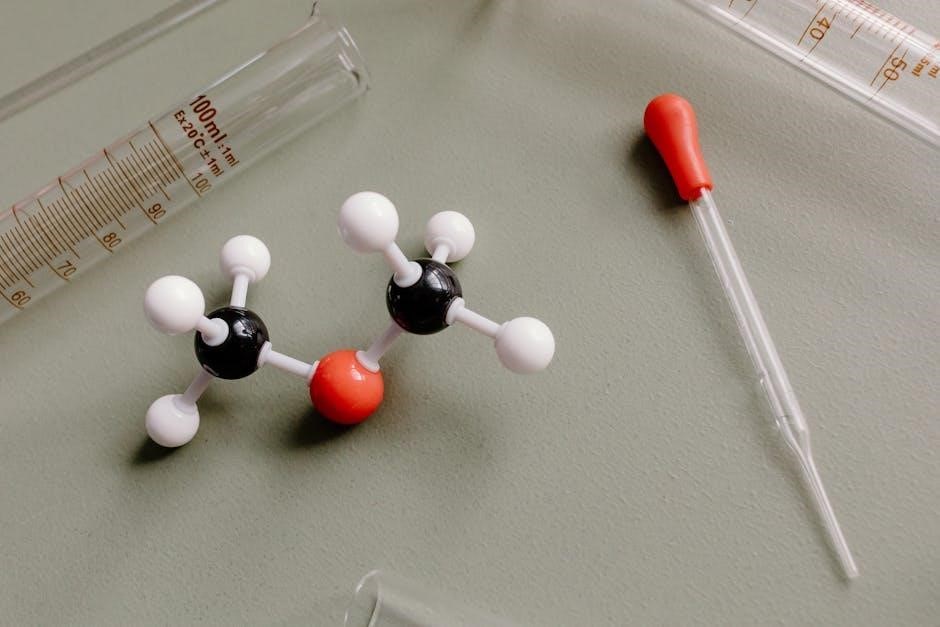
Lab values are essential for assessing patient health, guiding diagnosis, and monitoring treatment. Nurses rely on these measurable data to detect abnormalities and make informed care decisions, ensuring safe and effective patient outcomes.
1.1 Importance of Lab Values in Nursing Practice
Lab values are crucial for detecting abnormalities, monitoring treatment progress, and making informed clinical decisions. They provide measurable data to assess organ function, diagnose conditions, and guide patient care. Accurate interpretation ensures timely interventions, enhancing patient safety and outcomes. Nurses rely on lab values to identify trends and adjust care plans effectively.
1.2 Overview of Common Lab Tests and Their Significance
Common lab tests include CBC, BMP, and electrolyte panels, providing insights into blood components, organ function, and fluid balance. These tests help diagnose conditions, monitor treatment efficacy, and guide care decisions. Understanding their significance enables nurses to assess patient health, detect abnormalities, and develop targeted care plans for optimal outcomes.

Understanding Normal Lab Value Ranges
Normal lab value ranges serve as benchmarks for assessing patient health, varying by lab and factors like age and gender. They guide health assessments and care decisions.
2.1 Standard Reference Ranges and Variations
Standard reference ranges for lab values vary between laboratories due to differences in equipment and testing methods. These ranges are established based on healthy populations but can be influenced by factors like age, gender, and medical conditions. Nurses must consider the specific lab’s reference ranges when interpreting results to ensure accurate patient care.
2.2 Factors Influencing Normal Lab Values (Age, Gender, etc.)
Age, gender, and pregnancy significantly influence normal lab values. For instance, hemoglobin levels naturally decline with age, and creatinine clearance varies between genders. Pregnancy alters blood volume, affecting hematocrit and hemoglobin. Nurses must consider these factors to interpret lab results accurately and provide personalized patient care.
Common Nursing Lab Tests and Their Values
Common nursing lab tests include CBC, BMP, and organ function tests. These provide critical data on blood components, electrolytes, and organ health, guiding diagnosis and treatment plans.
3.1 Complete Blood Count (CBC) and Its Components
A CBC measures essential blood components, including red blood cell (RBC) count, hemoglobin (Hgb), hematocrit (Hct), white blood cell (WBC) count, and platelet count. These values help assess oxygen-carrying capacity, infection status, and bleeding risks. Normal ranges vary slightly by lab but are crucial for diagnosing anemia, infections, and blood disorders, guiding targeted nursing care and interventions.
3.2 Basic Metabolic Panel (BMP) and Electrolytes
The BMP assesses kidney function, fluid balance, and electrolyte levels, including sodium, potassium, chloride, calcium, and phosphate. These values are vital for detecting imbalances that can lead to complications like arrhythmias or seizures. Nurses monitor BMP results to guide fluid and electrolyte management, ensuring patient stability and preventing critical care issues through timely interventions and adjustments in treatment plans.
3.3 Liver and Kidney Function Tests
Liver function tests measure enzymes like ALT and AST, bilirubin, and proteins to assess hepatic health. Elevated levels may indicate liver damage or disease, guiding nurses in monitoring and managing care for conditions like hepatitis or cirrhosis.
Kidney function tests, including creatinine and BUN, evaluate renal health. These values help nurses detect issues like acute kidney injury or chronic kidney disease, enabling timely interventions to preserve organ function and prevent complications.

Interpreting Lab Results for Patient Care
Interpreting lab results is crucial for identifying abnormalities, monitoring treatment efficacy, and guiding clinical decisions. Nurses use these insights to detect early signs of complications and tailor care plans effectively.
4.1 Detecting Abnormalities and Their Implications
Detecting abnormalities in lab values is critical for early diagnosis and treatment. Nurses identify deviations from normal ranges, such as electrolyte imbalances or abnormal blood cell counts, which may indicate underlying conditions. These findings guide clinical decisions, ensuring timely interventions to prevent complications and improve patient outcomes. Accurate detection is vital for effective care.
4.2 Monitoring Treatment Progress Through Lab Values
Lab values are crucial for assessing treatment efficacy and adjusting care plans. By tracking changes in results, nurses can evaluate patient responses to therapies, such as improved blood glucose levels in diabetes or normalized kidney function post-intervention. This data-driven approach ensures personalized care and optimizes outcomes, helping nurses refine treatments effectively and safely.
4.3 Critical Thinking in Lab Value Interpretation
Critical thinking is vital for interpreting lab values, enabling nurses to analyze results in the context of a patient’s condition. This involves recognizing patterns, identifying deviations, and correlating data with clinical symptoms to make informed decisions. Nurses must consider factors like age, gender, and comorbidities to accurately interpret lab values and prioritize care.

Clinical Significance of Lab Values in Nursing
Lab values are crucial for diagnosing diseases, assessing organ function, and guiding treatment decisions. They provide measurable data to evaluate patient health, enabling nurses to detect abnormalities and monitor progress effectively.
Understanding lab values allows nurses to identify potential complications early, ensuring timely interventions and improving patient outcomes. They are essential for developing personalized care plans and optimizing treatment strategies.
5.1 Assessing Organ Function and Disease Diagnosis
Lab values are crucial for assessing organ function and diagnosing diseases. Tests like liver enzymes (ALT, AST) and kidney function (creatinine, BUN) help identify dysfunction. Abnormal results may indicate conditions such as hepatitis or renal failure, enabling nurses to make informed decisions and develop targeted care plans to address specific health issues effectively.
5.2 Role of Lab Values in Medication Management
Lab values guide medication management by monitoring drug efficacy and safety. Nurses use lab results to adjust dosages, preventing toxicity and ensuring therapeutic levels. For example, INR for anticoagulants and blood glucose for diabetes medications. Regular monitoring optimizes treatment outcomes and minimizes adverse effects, ensuring personalized and effective patient care.
5.3 Lab Values in Emergency and Critical Care Situations
Lab values are critical in emergencies, guiding immediate interventions. For instance, potassium levels prevent arrhythmias, lactate indicates sepsis severity, and troponin confirms myocardial infarction. Real-time lab data enables nurses to make life-saving decisions, such as fluid resuscitation or antidote administration, ensuring timely and targeted care in high-stakes situations.

Patient Monitoring and Lab Value Trends
Monitoring lab trends helps detect subtle changes, enabling early intervention. Nurses track patterns to assess treatment efficacy and identify potential complications, adjusting care plans accordingly for optimal patient outcomes.
6.1 Tracking Changes in Lab Values Over Time
Tracking lab value trends over time is crucial for assessing patient progress and detecting potential issues early. Nurses monitor these changes to identify gradual shifts, enabling timely interventions and informed clinical decisions to ensure patient safety and effective care.
6.2 Identifying Patterns and Potential Complications
Recognizing patterns in lab values helps nurses anticipate complications early. For instance, a steady rise in creatinine levels may signal kidney dysfunction, while falling hemoglobin levels could indicate bleeding or anemia. Proactive identification allows for early intervention, improving patient outcomes and preventing severe health issues.
6.3 Adjusting Care Plans Based on Lab Results
Lab results guide nurses in tailoring care plans to address patient needs. For example, elevated glucose levels may prompt insulin adjustments, while low hemoglobin levels might necessitate dietary changes. Continuous monitoring ensures timely interventions, optimizing treatment efficacy and enhancing patient outcomes through individualized care strategies.

Lab Values and Patient Safety
Lab values are crucial for ensuring patient safety by preventing complications and maintaining safe ranges for electrolytes and blood components. Nurses play a key role in identifying life-threatening abnormalities and intervening promptly to protect patients.
7.1 Preventing Complications Through Accurate Lab Monitoring
Accurate lab monitoring is vital for preventing complications by detecting abnormalities early. Nurses can identify trends, enabling timely interventions. Monitoring electrolytes and blood components helps avoid critical imbalances, ensuring patient safety and effective care, particularly in critical care and chronic conditions.
7.2 Ensuring Safe Ranges for Electrolytes and Blood Components
Nurses must monitor electrolytes like potassium, sodium, and calcium to prevent life-threatening imbalances. Maintaining normal ranges for blood components, such as hemoglobin and white blood cells, ensures proper bodily functions. Prompt interventions based on lab results help avoid complications, promoting patient safety and optimal health outcomes.
7.3 Role of Nurses in Identifying Life-Threatening Abnormalities
Nurses play a critical role in detecting life-threatening lab abnormalities, such as severe electrolyte imbalances or acute kidney injury. Accurate interpretation of lab values enables nurses to alert healthcare teams promptly, initiating interventions that can prevent complications and improve patient outcomes.
Communication and Documentation of Lab Values
Effective communication and accurate documentation of lab values ensure continuity of care. Clear reporting to healthcare teams and detailed records in EHRs support timely decisions, enhancing patient safety and outcomes.
8.1 Effective Reporting of Lab Results to Healthcare Teams
Clear and timely reporting of lab results is crucial for collaborative care. Nurses use standardized formats to communicate critical values, ensuring clarity and prompt action. Highlighting abnormal results and trends aids healthcare teams in making informed decisions, enhancing patient outcomes and safety. Accurate reporting fosters effective teamwork and ensures continuity of care.
8.2 Documenting Lab Trends in Electronic Health Records
Accurate documentation of lab trends in EHRs ensures continuity of care. Nurses record and track changes in lab values over time, enabling healthcare teams to identify patterns and make informed decisions. This systematic approach supports monitoring treatment efficacy and promptly addressing potential complications, enhancing patient safety and care coordination.
8.3 Patient Education on Lab Results and Their Implications
Nurses play a key role in educating patients about lab results, explaining their significance in simple terms. This empowers patients to understand their health, make informed decisions, and adhere to treatment plans. Clear communication fosters trust and active participation in care, helping patients manage conditions and adopt healthier lifestyles based on lab findings.

Resources for Learning Nursing Lab Values
Recommended textbooks, online tools, and NCLEX prep materials provide comprehensive guides for mastering lab values. These resources offer detailed explanations, quick reference charts, and practice questions to enhance learning and clinical application.
9.1 Recommended Textbooks and Guides for Nurses
Textbooks like Laboratory Tests and Diagnostic Procedures with Nursing Diagnoses by Corbett and Banks, and Normal Values of Common Laboratory Tests by Vallerand, provide detailed explanations of lab values. These resources, along with guides from Nursing.com, offer comprehensive insights, helping nurses interpret lab results and apply them to patient care effectively.
9.2 Online Tools and Cheat Sheets for Quick Reference
Online platforms like Nursing.com offer cheat sheets and quick reference guides for lab values. These tools provide concise, accessible information on normal ranges, enabling nurses to interpret results efficiently. They are ideal for NCLEX preparation and daily clinical practice, ensuring accurate and timely decision-making.
9.3 NCLEX Preparation Materials for Lab Value Mastery
NCLEX preparation materials, such as guides and practice questions, focus on critical lab values and their clinical implications. These resources help nurses master essential ranges and abnormal findings, ensuring readiness for exam success and safe patient care.

Staying Updated on Lab Value Guidelines
Lab value guidelines evolve with medical advancements, requiring nurses to stay informed through professional recommendations and continuous learning to ensure accurate interpretation and improved patient care.
10.1 Changes in Reference Ranges and Testing Methods
Reference ranges and testing methods for lab values are periodically updated based on advancements in medical research and technology. Nurses must stay informed about these changes to accurately interpret results and integrate them into patient care plans, ensuring evidence-based practice and optimal outcomes.
10.2 Industry Standards and Professional Recommendations
Professional organizations establish standardized guidelines for lab value interpretation, ensuring consistency across healthcare settings. Nurses adhere to these recommendations to maintain quality care, relying on evidence-based practices to guide decision-making and patient management effectively.
10.3 Continuous Learning Opportunities for Nurses
Nurses engage in ongoing education to stay updated on lab value guidelines. Through workshops, online courses, and professional resources, they enhance their knowledge, ensuring accurate interpretation and application of lab results in patient care. Continuous learning fosters expertise, enabling nurses to provide high-quality, evidence-based care in a rapidly evolving healthcare landscape.

Case Studies and Practical Applications
Case studies provide real-life examples of lab value interpretation, helping nurses apply theoretical knowledge in clinical settings. Practical applications enhance understanding and improve decision-making skills for effective patient care.
11.1 Real-Life Scenarios Involving Lab Value Interpretation
Real-life scenarios demonstrate how nurses interpret lab values to guide patient care. For example, a patient with low hemoglobin may indicate anemia, prompting further testing. Elevated creatinine levels suggest kidney dysfunction, requiring adjusted medication. Trends in lab values, such as rising glucose levels, guide insulin adjustments. These scenarios enhance critical thinking and clinical decision-making skills;
11.2 Applying Lab Values in Nursing Care Plans
Lab values are integral to nursing care plans, enabling tailored interventions. For instance, abnormal electrolytes guide fluid and medication adjustments. Elevated liver enzymes prompt monitoring for hepatic issues. By incorporating lab data, nurses develop targeted goals, such as stabilizing blood glucose or improving renal function, ensuring individualized and evidence-based patient care;
11.3 Lessons Learned from Clinical Experiences
Clinical experiences highlight the importance of lab values in patient care. Real-life scenarios teach nurses to recognize patterns, such as electrolyte imbalances or fluid status changes, and their impact on patient outcomes. These insights enhance critical thinking, ensuring timely interventions and improving care effectiveness through practical, hands-on understanding of lab value significance.
Lab values are crucial for effective patient care, enabling nurses to diagnose, monitor, and treat conditions accurately. Continuous learning and adaptation ensure optimal use of lab data in nursing practice.
12.1 Summary of Key Concepts
Lab values are essential for diagnosing, monitoring, and treating patients. They provide insights into bodily functions, detect abnormalities, and guide treatment decisions. Nurses use lab values to ensure patient safety, monitor progress, and deliver effective care, making them a cornerstone of nursing practice and patient management.
12.2 The Future of Lab Value Integration in Nursing Practice
The integration of lab values in nursing will advance with technology, such as AI-driven real-time analysis and telehealth platforms. These tools will enhance decision-making, enable remote monitoring, and improve patient outcomes. Future nurses will leverage these innovations to deliver personalized, data-driven care, ensuring safer and more efficient patient management.